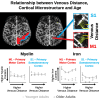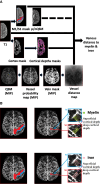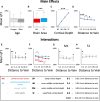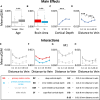Age-related differences in human cortical microstructure depend on the distance to the nearest vein
- PMID: 39355004
- PMCID: PMC11443451
- DOI: 10.1093/braincomms/fcae321
Age-related differences in human cortical microstructure depend on the distance to the nearest vein
Abstract
Age-related differences in cortical microstructure are used to understand the neuronal mechanisms that underlie human brain ageing. The cerebral vasculature contributes to cortical ageing, but its precise interaction with cortical microstructure is poorly understood. In a cross-sectional study, we combine venous imaging with vessel distance mapping to investigate the interaction between venous distances and age-related differences in the microstructural architecture of the primary somatosensory cortex, the primary motor cortex and additional areas in the frontal cortex as non-sensorimotor control regions. We scanned 18 younger adults and 17 older adults using 7 Tesla MRI to measure age-related changes in longitudinal relaxation time (T1) and quantitative susceptibility mapping (QSM) values at 0.5 mm isotropic resolution. We modelled different cortical depths using an equi-volume approach and assessed the distance of each voxel to its nearest vein using vessel distance mapping. Our data reveal a dependence of cortical quantitative T1 values and positive QSM values on venous distance. In addition, there is an interaction between venous distance and age on quantitative T1 values, driven by lower quantitative T1 values in older compared to younger adults in voxels that are closer to a vein. Together, our data show that the local venous architecture explains a significant amount of variance in standard measures of cortical microstructure and should be considered in neurobiological models of human brain organisation and cortical ageing.
Keywords: arteries; iron; laminar imaging; neurodegeneration; ultra-high field MRI.
© The Author(s) 2024. Published by Oxford University Press on behalf of the Guarantors of Brain.
Conflict of interest statement
The authors report no competing interests.
Figures






Similar articles
-
Quantitative MRI susceptibility mapping reveals cortical signatures of changes in iron, calcium and zinc in malformations of cortical development in children with drug-resistant epilepsy.Neuroimage. 2021 Sep;238:118102. doi: 10.1016/j.neuroimage.2021.118102. Epub 2021 May 29. Neuroimage. 2021. PMID: 34058334 Free PMC article.
-
Evaluation of brain ageing: a quantitative longitudinal MRI study over 7 years.Eur Radiol. 2017 Apr;27(4):1568-1576. doi: 10.1007/s00330-016-4485-1. Epub 2016 Jul 5. Eur Radiol. 2017. PMID: 27379992
-
In vivo irreversible and reversible transverse relaxation rates in human cerebral cortex via line scans at 7 T with 250 micron resolution perpendicular to the cortical surface.Magn Reson Imaging. 2022 Jul;90:44-52. doi: 10.1016/j.mri.2022.04.001. Epub 2022 Apr 6. Magn Reson Imaging. 2022. PMID: 35398027 Free PMC article.
-
Quantitative susceptibility mapping of brain iron in healthy aging and cognition.Neuroimage. 2023 Nov 15;282:120401. doi: 10.1016/j.neuroimage.2023.120401. Epub 2023 Oct 5. Neuroimage. 2023. PMID: 37802405 Free PMC article. Review.
-
Microstructural imaging of human neocortex in vivo.Neuroimage. 2018 Nov 15;182:184-206. doi: 10.1016/j.neuroimage.2018.02.055. Epub 2018 Mar 26. Neuroimage. 2018. PMID: 29588229 Review.
Cited by
-
Assessing Arterial Patterns in the Motor Cortex With 7 Tesla Magnetic Resonance Imaging and Vessel Distance Mapping.Hum Brain Mapp. 2025 Aug 1;46(11):e70311. doi: 10.1002/hbm.70311. Hum Brain Mapp. 2025. PMID: 40762423 Free PMC article.
References
-
- Huck J, Wanner Y, Fan AP, et al. High resolution atlas of the venous brain vasculature from 7 T quantitative susceptibility maps. Brain Struct Funct. 2019;224(7):2467–2485. - PubMed
LinkOut - more resources
Full Text Sources
